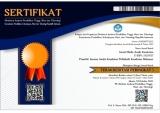Use Consumable Salt Concentration in Process Flotation Intestine Worm Eggs
DOI:
https://doi.org/10.32382/jmak.v14i2.270Kata Kunci:
Concentration, Consumption, SaltAbstrak
Salt is a chemical that is often used in families as a food flavoring or as a food preservative with the main substance being Sodium Chloride (NaCl). Re-fined salt as an ingredient for public consumption can be used in the laboratory as an alternative material to replace saturated NaCl (pa) for flotation of nematode worm eggs. The purpose of this study is to find out certain brands of consumable salt that can be used to float in-testinal nematode worm eggs. Method this research is a laboratory experiment where samples of consumed salt are treated and suspension is added and then the results of the treatment are observed microscopically. The results of this research is a good concentra-tion for the flotation process of 4 brands of consumable salt is 32% and the brand that can be used as a medium in the flotation process is the BTM salt brand. Conclusion this research is the BTM consumption salt brand provides good results in the flotation process by floating three species of intestinal nematose eggs, namely; round-worms, whipworms, hookworms (N. americanus and A. duodenale)
Referensi
Ahda, F.A., Sari, G.N. and Farokhah, L. (2020) ‘Sistem pakar penentuan kualitas garam di desa sedayulawas kabupaten lamongan menggunakan metode forward chaining’, Jurnal Ilmiah Teknologi Informasi Asia, 14(1), p. 41. Available at: https://doi.org/10.32815/jitika.v14i1.447.
Amoah, I.D. et al. (2017) ‘Detection and quantification of soil-transmitted helminths in environmental samples: A review of current state-of-the-art and future perspectives’, Acta Tropica, 169, pp. 187–201. Available at: https://doi.org/10.1016/j.actatropica.2017.02.014.
Anggraini, D.A. et al. (2020) ‘identifikasi telur nematoda usus soil transmitted helminths (STH) pada kuku jari tangan pekerja tempat penitipan hewan metode pengapungan (flotasi) menggunakan NaCl’, Jurnal Ilmu Kesehatan Bhakti Husada: Health Sciences Journal, 11(2), pp. 121–136. Available at: https://doi.org/10.34305/jikbh.v11i2.166.
Apriana, D. (2020) ‘Identifikasi telur nematoda usus soil transmitted helmint (STH) metode flotasi pada kuku petani’, TLM [Preprint].
Aritonang, E. and Mahyudi (2015) ‘Identifikasi telur cacing Ascaris lumbricoides metode kato pada tinja anak sdn 104186 kelas III-IV desa’, Jurnal Kesehatan Masyarakat dan Lingkungan Hidup, pp. 422–433.
Asman et al. (2020) ‘Gambaran telur cacing balita stunting menggunakan pewarnaan antosianin dari ekstrak ubi ungu metode flotasi di kabupaten bulukumba’, Jurnal TLM Blood Smear, 1(1), pp. 6–13. Available at: https://ojs.stikespanritahusada.ac.id/index.php/JMLT/article/view/394%0Ahttps://ojs.stikespanritahusada.ac.id/index.php/JMLT/article/download/394/191.
Hoiriyah, Y.U. (2019) ‘Peningkatan kualitas produksi garam menggunakan teknologi geomembran’, Jurnal Studi Manajemen dan Bisnis, 6(2), pp. 71–76. Available at: https://doi.org/10.21107/jsmb.v6i2.6684.
Jaya, N.T.S.P., Hartati, R. and Widianingsih, W. (2016) ‘produksi garam dan bittern di tambak garam’, Jurnal Kelautan Tropis, 19(1), p. 43. Available at: https://doi.org/10.14710/jkt.v19i1.599.
Maulana, K.D. et al. (2017) ‘Peningkatan kualitas garam bledug kuwu melalui proses rekristalisasi dengan pengikat pengotor CaO, Ba(OH)2, dan (NH4)2CO3’, Journal of Creativity Student, 2(1), pp. 42–46. Available at: https://doi.org/10.15294/jcs.v2i1.13237.
Ngwese, M.M. et al. (2020) ‘Diagnostic techniques of soil-transmitted helminths: Impact on control measures’, Tropical Medicine and Infectious Disease, 5(2). Available at: https://doi.org/10.3390/tropicalmed5020093.
Rashid, M.H. et al. (2018) ‘Comparison of McMaster and FECPAKG2 methods for counting nematode eggs in the faeces of alpacas’, Parasites and Vectors, 11(1), pp. 10–13. Available at: https://doi.org/10.1186/s13071-018-2861-1.
Rosdarni, W. ode hasina (2021) ‘Perbedaan kejelasan dan kekontrasan pada pemeriksaan telur cacing gelang (Ascaris lumbricoides) antara metode kato-katz dan metode langsung (direct slide)’, Jurnal MediLab Mandala Waluya, 5(2), pp. 1–11.
Soedarto (2019) Parasitologi klinik. Surabaya: Airlangga Universitas Press.
Sumada, K., Dewati, R. and Suprihatin (2016) ‘Garam industri berbahan baku garam krosok dengan metode pencucian dan evaporasi’, Jurnal Teknik Kimia, 11(1), pp. 30–36.
Sumantri, Dr.H.Arief, SKM., M.K. (2015) Metode penelitian kesehatan. 3rd edn. Edited by E. Prof. Dr. Murodi, M.A & dr. Fika Ekayanti, M.Med. Jakarta.: Kencana Prenada Media Group.
Suraini, S. and Sophia, A. (2020) ‘Evaluasi dan uji kesesuaian pemeriksaan telur cacing soil transmitted helminths menggunakan metode, langsung, sedimentasi dan flotasi’, Prosiding Seminar Kesehatan Perintis, 3(2), pp. 31–36.
Widarti, W. (2018) ‘Identifikasi telur nematoda usus pada kol (Brassica oleraceae) di pasar tradisional kota makassar’, Jurnal Media Analis Kesehatan, 1(1), pp. 78–82. Available at: https://doi.org/10.32382/mak.v1i1.226.
Widiyanti, F., Nuryati, A. and Nuryani, S. (2020) ‘Lama pengapungan terhadap jumlah telur Soil Transmitted Helminth metode flotasi’, Jurnal Vokasi Kesehatan, 6(1), pp. 52–55. Available at: http://ejournal.poltekkes-pontianak.ac.id/index.php/JVK 52.
Unduhan
Diterbitkan
Terbitan
Bagian
PDF downloaded: 4130







